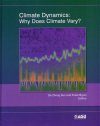![Climate Dynamics Climate Dynamics]()
Click to have a closer look
About this book
Contents
Customer reviews
Biography
Related titles
About this book
Climate Dynamics: Why Does Climate Vary? presents the major climate phenomena within the climate system to underscore the potency of dynamics in giving rise to climate change and variability. These phenomena include deep convection over the Indo-Pacific warm pool and its planetary-scale organization: the Madden-Julian Oscillation, the monsoons, the El Niño-Southern Oscillation, the Pacific Decadal Oscillation, and the low-frequency variability of extratropical circulations. The volume also has a chapter focusing on the discussion of the causes of the recent melting of Arctic sea ice and a chapter devoted to the discussion of the causes of recent changes in the frequency and intensity of tropical cyclones. On each topic, the basic material of climate dynamics is covered to aid the understanding of the forefront research, making Climate Dynamics: Why Does Climate Vary? accessible to a broad spectrum of readers.
The volume highlights include
- Diabatic and nonlinear aspects of the El Niño-Southern Oscillation
- Causes of sea ice melting in the Arctic
- Impact of global warming on tropical cyclone activity
- Origins of the Pacific Decadal Oscillation
- Causes of climate variability of Asian monsoons
The volume will be of particular interest to graduate students and young researchers in atmospheric and oceanic sciences and related disciplines such as geology and geography. Climate Dynamics: Why Does Climate Vary? will also be a good read for those who have a more general interest in the Earth's climate and why it varies.
Contents
Preface
Introduction
- The Multiscale Organization of Moist Convection and the Intersection of Weather and Climate
- Monsoon Climate Variabilities
- A Brief Introduction to El Niño and La Niña
- A Linear Stochastic Model of Tropical Sea Surface Temperatures Related to El Niño
- The Diabatic and Nonlinear Aspects of the El Niño-Southern Oscillation: Implications for Its Past and Future Behavior
- El Niño-Southern Oscillation Ocean Dynamics: Simulation by Coupled General Circulation Models
- Extratropical Air-Sea Interaction, Sea Surface Temperature Variability, and the Pacific Decadal Oscillation
- Northern Hemisphere Extratropical Tropospheric Planetary Waves and Their Low-Frequency Variability: Their Vertical Structure and Interaction With Transient Eddies and Surface Thermal Contrasts
- Arctic Sea Ice and the Potential for Abrupt Loss
- Global Warming and Tropical Cyclone Activity in the Western North Pacific From an Observational Perspective
Customer Reviews
Biography







































